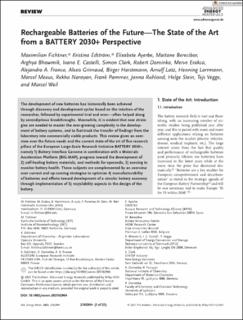| dc.contributor.author | Clark, Simon | |
| dc.contributor.author | Fichtner, Maximilian | |
| dc.contributor.author | Edström, Kristina | |
| dc.contributor.author | Ayerbe, Elixabete | |
| dc.contributor.author | Berecibar, Maitane | |
| dc.contributor.author | Bhowmik, Arghya | |
| dc.contributor.author | Castelli, Ivano E. | |
| dc.contributor.author | Dominko, Roberto | |
| dc.contributor.author | Erakca, Merve | |
| dc.contributor.author | Franco, Alejandro A. | |
| dc.contributor.author | Grimaud, Alexis | |
| dc.contributor.author | Horstmann, Birger | |
| dc.contributor.author | Latz, Arnulf | |
| dc.contributor.author | Lorrmann, Henning | |
| dc.contributor.author | Meeus, Marcel | |
| dc.contributor.author | Narayan, Rekha | |
| dc.contributor.author | Pammer, Frank | |
| dc.contributor.author | Ruhland, Janna | |
| dc.contributor.author | Stein, Helge | |
| dc.contributor.author | Vegge, Tejs | |
| dc.contributor.author | Weil, Marcel | |
| dc.date.accessioned | 2022-09-08T12:49:34Z | |
| dc.date.available | 2022-09-08T12:49:34Z | |
| dc.date.created | 2021-12-09T17:00:52Z | |
| dc.date.issued | 2021 | |
| dc.identifier.issn | 1614-6832 | |
| dc.identifier.uri | https://hdl.handle.net/11250/3016649 | |
| dc.description.abstract | The development of new batteries has historically been achieved through discovery and development cycles based on the intuition of the researcher, followed by experimental trial and error—often helped along by serendipitous breakthroughs. Meanwhile, it is evident that new strategies are needed to master the ever-growing complexity in the development of battery systems, and to fast-track the transfer of findings from the laboratory into commercially viable products. This review gives an overview over the future needs and the current state-of-the art of five research pillars of the European Large-Scale Research Initiative BATTERY 2030+, namely 1) Battery Interface Genome in combination with a Materials Acceleration Platform (BIG-MAP), progress toward the development of 2) self-healing battery materials, and methods for operando, 3) sensing to monitor battery health. These subjects are complemented by an overview over current and up-coming strategies to optimize 4) manufacturability of batteries and efforts toward development of a circular battery economy through implementation of 5) recyclability aspects in the design of the battery. | en_US |
| dc.language.iso | eng | en_US |
| dc.publisher | Wiley | en_US |
| dc.rights | Navngivelse 4.0 Internasjonal | * |
| dc.rights.uri | http://creativecommons.org/licenses/by/4.0/deed.no | * |
| dc.title | Rechargeable Batteries of the Future—The State of the Art from a BATTERY 2030+ Perspective | en_US |
| dc.type | Peer reviewed | en_US |
| dc.type | Journal article | en_US |
| dc.description.version | publishedVersion | en_US |
| dc.rights.holder | © 2021 The Authors. Advanced Energy Materials published by Wiley-VCH GmbH | en_US |
| dc.source.pagenumber | 24 | en_US |
| dc.source.volume | 12 | en_US |
| dc.source.journal | Advanced Energy Materials | en_US |
| dc.source.issue | 17 | en_US |
| dc.identifier.doi | 10.1002/aenm.202102904 | |
| dc.identifier.cristin | 1966811 | |
| dc.source.articlenumber | 2102904 | en_US |
| cristin.ispublished | true | |
| cristin.fulltext | original | |
| cristin.qualitycode | 1 | |

